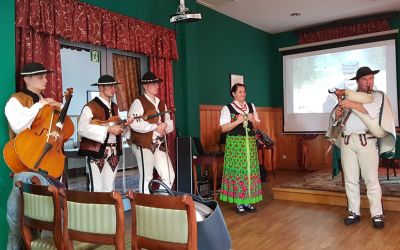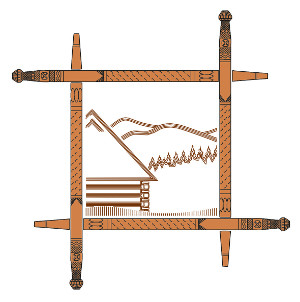
Speaking of "pastoral" music in the Boyko and Lemko regions, at the beginning it should be emphasized that these are two types of music. The music that accompanied them during games, weddings, holidays (including funerals) and "strictly" shepherd's music, i.e. performed by shepherds in the hut on the mountain pastures.
The range of typical instruments used by the shepherds themselves was not very wide. First of all, these are signal instruments, the main role of which is played by the Trombita.
Shepherd's horn, on the other hand, is one of the most archaic instruments used by shepherds and not only since ancient times. It was usually made of the buffalo or sheep horns. The strength and timbre of the sound depended on its length. It is also an instrument for communication between shepherds. It is easier to use due to its smaller size and weight than trombites. While trombites were usually used in the hut on mountain pastures, the horn could be owned by a single shepherd and moved with him. It was convenient means of communication, e.g. when grazing in the forest or in forest clearings.
Another instrument commonly used by shepherds (but not only) was a mouth-bow. Small, characteristic Boyko drums made the time more pleasant and their transport did not require any effort. Boyko women often played this instrument to pass the time and while travelling.
The drum is played, holding it in the mouth and jerking the movable uvula with a finger. The immovable part of the instrument rests on the teeth. Changes in the height and tone of the sound are achieved by changing the position of the oral cavity (through appropriate movements of the tongue and palate), changing the position of the mouth and throat, and by pulling in or exhaling air.
In the hut on the mountain pasture the shepherds also made their time more pleasant by playing various melodies using shepherd's pipes (sopiłki). It is also one of the oldest simple folk instruments. It was performed from branches of: snowball trees, lilac, hazel, reed. Its length reaches 30-40 cm. In the lower part it has 5-6 holes. In various regions of the Carpathian Mountains there are different types of shepherd's pipes.
The Lemkivshchyna and Boyko region is the last northern destination place of the music of Csardas and Verbunk, which is so well known and popular on the southern side of the Carpathian Mountains. Many songs are based on this music. A characteristic feature is the presence of syncopation.
A very important cultural curiosity is the fact that the kolomyka already exists in the Western Boyko region. Here, in our Bieszczady Mountains, crazy funny kolomyjki were danced and sung and they still can be heard on the mountain pastures of the Eastern Carpathian Mountains up to Romania. These traditions are undoubtedly worth continuing. An example of Eastern Carpathian shepherd's dance is the impressive, the so-called "zbójnicki" dance - Arkan.
The landscape of a piedmont town or village was complemented by a wandering grandfather – a lyrist, who played religious songs, secular ballads and news from a distant world while begging by playing the hurdy gurdy.
Carpathian Gypsies were invited to weddings, family celebrations or other important events for the community.














